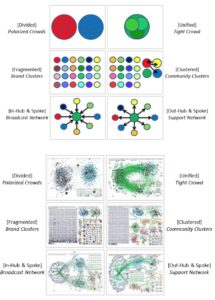Among my most treasured resources online is the Pew Internet Research website. On this website, “Big Data” is given real human impact in exactly the kinds of ways universities across the country (including the U of R, for which I developed a site. Plug, plug, plug) are striving.
Recently and crucially, Pew has released a series of Twitter conversation illustrations, what they’re calling “maps,” to better understand how relationships on Twitter work out:
Mapping Twitter Topic Networks: From Polarized Crowds to Community Clusters
People connect to form groups on Twitter for a variety of purposes. The networks they create have identifiable contours that are shaped by the topic being discussed, the information and influencers driving the conversation, and the social network structures of the participants.
At first blush, a lot of this information seems obvious, and on the surface it is. Like a lot of science rather than revealing wholly new information, social media mapping codifies and confirms that information we have already inferred.
Political discussions tend to create isolated clusters of polarized conversation, like those modeled at the top left side of the diagram. Support staff are always actively seeking out conversations with strangers who have brand-related issues, creating outward-facing spokes like those in the third row, right side.
But even if it is simple – perhaps especially because it is simple – it is also an easy concept to overlook. What does your brand hope to foster out of your social media efforts? Community? Support? Sales leads? And which of these conversation maps best fits your goals?
Knowing how your communities aught to look goes a long way towards understanding how you should be gauging success. It is not, for example, important to track link clicks if you’re primarily on Twitter for social support and brand protection. It is, however, important to track both the response rate and response time you’re giving too and getting from your customer base.
If fostering a community around your brand is something you value, then tracking clicks, comments and especially resharing is essential. As is seeking out that community and monitoring their conversations through a list. As is creating and monitoring hash tags.
In practice, your social network will doubtless be a blend of the many types of mapped conversations you see here. And perhaps all of the various mappings are important to you. But by focusing on social media mapping as a strategy, you can better understand your place in the community and what it will take to get where you need to go.




